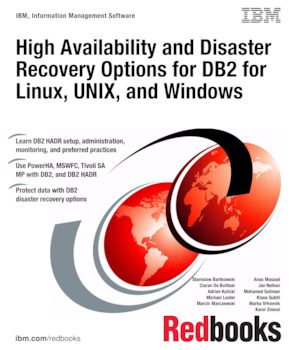About cookies on this site Our websites require some cookies to function properly (required). In addition, other cookies may be used with your consent to analyze site usage, improve the user experience and for advertising. For more information, please review your options. By visiting our website, you agree to our processing of information as described in IBM’sprivacy statement. To provide a smooth navigation, your cookie preferences will be shared across the IBM web domains listed here.

Published on 11 October 2012, updated 18 October 2012
Read in Google Books Order hardcopy
Share this page:
ISBN-10: 0738437344
ISBN-13: 9780738437347
IBM Form #: SG24-7363-02
Authors: Stanislaw Bartkowski, Ciaran De Buitlear, Adrian Kalicki, Michael Loster, Marcin Marczewski, Anas Mosaad, Jan Nelken, Mohamed Soliman, Klaus Subtil, Marko Vrhovnik and Karol Zimnol
Abstract
As organizations strive to do more with less, IBM® DB2® for Linux, UNIX, and Windows provides various built-in high availability features. DB2 further provides high availability solutions by using enterprise system resources with broad support for clustering software, such as IBM PowerHA® SystemMirror®, IBM Tivoli® System Automation for Multiplatforms (Tivoli SA MP), and Microsoft Windows Cluster Server.
This IBM Redbooks® publication describes the DB2 high availability functions and features, focusing on High Availability Disaster Recovery (HADR) in the OLTP environment. The book provides a detailed description of HADR, including setup, configuration, administration, monitoring, and preferred practices.
This book explains how to configure Cluster software PowerHA, Tivoli SA MP, and MSCS with DB2 and show how to use these products to automate HADR takeover.
DB2 also provides unprecedented enterprise-class disaster recovery capability. This book covers single system view backup, backup and restore with snapshot backup, and the db2recovery command, in detail.
This book is intended for database administrators and information management professionals who want to design, implement, and support a highly available DB2 system.
Table of Contents
Chapter 1. DB2 high availability and disaster recovery overview
Chapter 2. DB2 with IBM Tivoli System Automation for Multiplatforms
Chapter 3. DB2 and PowerHA SystemMirror
Chapter 4. DB2 with Microsoft Windows Failover Cluster
Chapter 5. DB2 HADR introduction
Chapter 6. HADR setup
Chapter 7. HADR with clustering software
Chapter 8. HADR monitoring
Chapter 9. DB2 and system upgrades
Chapter 10. Automatic client reroute
Chapter 11. HADR configuration parameters and registry variables
Chapter 12. Backup and recovery
Chapter 13. Q replication
Chapter 14. IBM InfoSphere Change Data Capture
Chapter 15. Geographically dispersed high availability and disaster recovery solutions
Appendix A. PowerHA application server scripts
Appendix B. IBM Tivoli System Automation for Multiplatforms takeover scripts